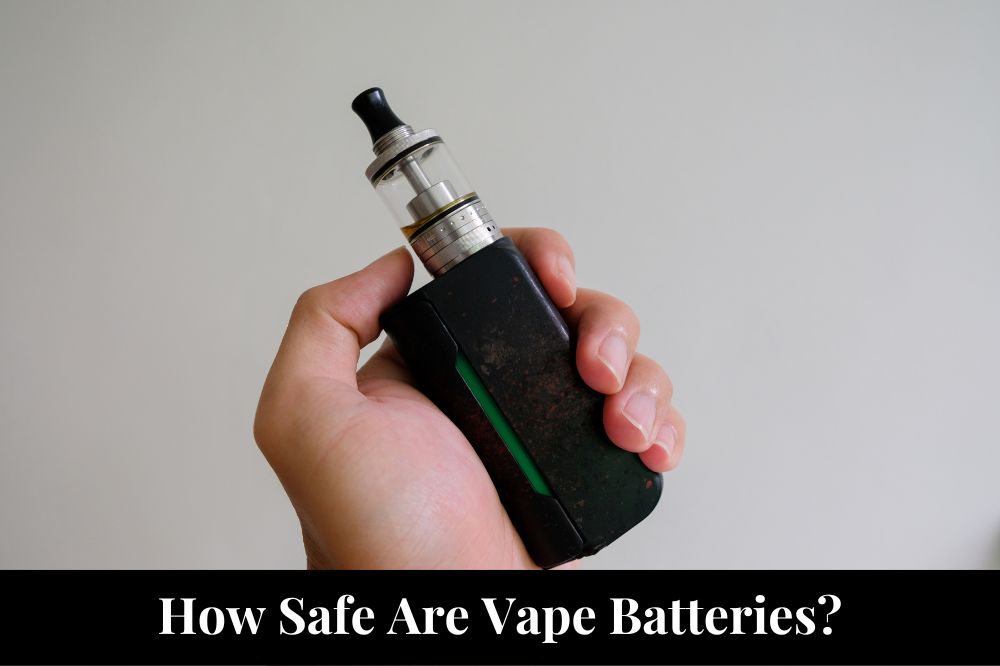
If you’re a vaper, you know that battery safety is important. But how safe are vape batteries, really? With the increasing popularity of vaping, it’s important to understand the potential risks associated with vape batteries.
Lithium-ion batteries, which are commonly used in vape devices, are generally safe when used properly. However, there have been incidents of vape batteries exploding or catching fire, which can cause serious injury. It’s important to understand the proper way to handle, charge, and store your vape batteries to minimize the risk of accidents.
In this article, we will explore the dos and don’ts of vape battery safety, as well as provide tips for safe usage and maintenance. By following these guidelines, you can ensure a safe and enjoyable vaping experience.
Understanding Vape Batteries
When it comes to vaping, battery safety is crucial. Understanding the different types of vape batteries and their specifications can help you ensure a safe vaping experience.
SPIRITBAR Katana BP10000
- Slender, leather-textured body reminiscent of a katana handle for an authentic samurai feel
- Unique samurai-inspired e-liquid flavor - fruity yet not too sweet, with a luxurious, elegant aroma
- Powerful 650mAh rechargeable battery for extended vaping time
- Large 18ml e-liquid capacity and 10,000 puff capacity
- Advanced mesh coil and e-liquid & power display screens for optimal vaping experience
The special juice captures the essence of the samurai spirit with its rich, smoothly pulsating flavor that brings new satisfaction with every puff. The device's slender, leather-textured design evokes the grip of a samurai's katana, making this product a perfect choice for beginner vapors.
Types of Vape Batteries
Vape batteries come in different shapes and sizes, but the most common types are cylindrical and rectangular. The chemical combinations used in vape batteries include Lithium Manganese Round cells (IMR), Lithium Nickel Round cells (INR), and Lithium Cobalt Round cells (ICR), among others.
IMR batteries are known for their high discharge rates and low internal resistance, making them ideal for sub-ohm vaping. INR batteries offer a balance between capacity and discharge rate, while ICR batteries have the highest energy density but are generally less stable than the other two types.
SPIRITBAR Jack’s Flask 9000 Puffs
- Stylish pirate flask-shaped body providing an exciting vaping experience
- Delivering up to 9000 puffs per device
- 20ml e-liquid capacity with 50mg nicotine strength for satisfying throat hit
- Specialized pirate-themed e-juice flavors for rich, swirling taste
- Premium mesh coil optimizes flavor profile for maximum vaping enjoyment
This disposable vape captures the daring spirit of the high seas with its flask styling and signature pirate e-juice flavors. The extraordinary battery life provides 9000 indulgent puffs for extended vaping pleasure. Live boldly and freely with the Jack's Flask - a legendary vaping experience fit for a pirate's adventures.
Battery Specifications
When choosing a vape battery, it’s important to pay attention to its specifications. Batteries are rated for voltage (V) and discharge current (C). The voltage rating determines the power output of the battery, while the discharge current rating determines how much current the battery can safely supply.
It’s also important to consider the capacity of the battery, which is measured in milliampere-hours (mAh). This rating indicates how long the battery will last before needing to be recharged.
When using vape batteries, it’s important to follow proper charging and storage procedures to ensure their safety. Always use the correct charging cable and avoid overcharging the battery. Store batteries in a cool, dry place away from direct sunlight and heat sources.
By understanding the different types of vape batteries and their specifications, you can make informed decisions and ensure a safe vaping experience.
Safety Concerns with Vape Batteries
When it comes to vaping, battery safety is important to avoid any accidents or injuries. Here are some potential risks and common user mistakes to be aware of.
SPIRITBAR Katana BP10000
- Slender, leather-textured body reminiscent of a katana handle for an authentic samurai feel
- Unique samurai-inspired e-liquid flavor - fruity yet not too sweet, with a luxurious, elegant aroma
- Powerful 650mAh rechargeable battery for extended vaping time
- Large 18ml e-liquid capacity and 10,000 puff capacity
- Advanced mesh coil and e-liquid & power display screens for optimal vaping experience
The special juice captures the essence of the samurai spirit with its rich, smoothly pulsating flavor that brings new satisfaction with every puff. The device's slender, leather-textured design evokes the grip of a samurai's katana, making this product a perfect choice for beginner vapors.
Potential Risks
Vape batteries can pose a risk of explosion or fire if not handled properly. According to the FDA, the exact causes of vape fires or explosions are not yet clear, but some evidence suggests that battery-related issues may be a cause.
In addition, extreme temperatures can damage your device’s battery. It is best to keep your device between 50 and 115 degrees Fahrenheit, according to Granite Vapor.
Common User Mistakes
Here are some common user mistakes to avoid to ensure the safety of your vape battery:
- Using damaged batteries: Never use damaged batteries, as they can be dangerous. If the wrapping is damaged or frayed, or your battery fails to keep charge, dispose of the battery safely, as advised by Vaporesso.
- Leaving battery charging unattended: Not keeping an eye on your vape while it’s charging is a safety risk. Always keep an eye on your device while it’s charging, and never leave it unattended.
- Putting batteries in your pocket: Don’t put batteries in your pocket, as they can come into contact with other metal objects and cause a short circuit.
- Not using a battery case: Invest in a battery case for safe transport. This will protect your battery from damage and prevent it from coming into contact with other metal objects.
By being aware of these potential risks and common user mistakes, you can ensure the safety of your vape battery and enjoy a worry-free vaping experience.
Preventing Battery Accidents
Vape batteries can be dangerous if not used and maintained properly. Here are some tips to help you prevent battery accidents:
Safe Usage Tips
- Always use the correct charger for your vape battery. Using the wrong charger can damage your battery and increase the risk of a fire or explosion.
- Avoid charging your battery overnight or leaving it unattended while charging. Overcharging can cause your battery to overheat and potentially explode.
- Do not expose your battery to extreme temperatures, such as leaving it in a hot car or in direct sunlight. This can cause your battery to overheat and potentially explode.
- Store your battery in a cool, dry place away from metal objects, such as keys or coins, which can cause a short circuit.
- Do not carry loose batteries in your pocket or purse. Always use a battery case to prevent accidental contact with metal objects.
Proper Battery Maintenance
- Inspect your battery regularly for any signs of damage, such as dents or scratches. If you notice any damage, stop using the battery immediately and dispose of it properly.
- Check the battery wrap for any tears or damage. If the wrap is damaged, re-wrap the battery or replace it.
- Always use the same type of batteries in your vape device. Mixing different types of batteries can cause them to discharge unevenly, which can damage your device or cause a fire.
- Replace your battery when it starts to lose its charge quickly or when it no longer holds a charge. Using a battery that is past its lifespan can increase the risk of a fire or explosion.
By following these safe usage tips and proper battery maintenance practices, you can help ensure the safety of yourself and those around you while using your vape device.
Regulations and Standards
When it comes to vape batteries, there are both government regulations and industry standards that aim to ensure their safety. Here are some of the key regulations and standards you should be aware of:
Government Regulations
The U.S. Food and Drug Administration (FDA) has issued policies for battery-operated tobacco products and e-liquids. Manufacturers of battery-operated tobacco products and e-liquids must comply with the UL 8139 Standard for Safety for Electrical Systems of Electronic Cigarettes and Vaping Devices. This voluntary industry standard aims to ensure the safety of these products.
Additionally, the FDA enforces the law to regulate e-cigarettes. Since 2016, the FDA has issued more than 8,000 warning letters to retailers, both online and in brick-and-mortar stores, to enforce the law and ensure the safety of e-cigarettes.
Industry Standards
The International Electrotechnical Commission (IEC) has developed standards for rechargeable lithium-ion batteries, which are commonly used in vape batteries. The IEC 62133 standard specifies safety requirements and test methods for these batteries.
Furthermore, the Institute of Electrical and Electronics Engineers (IEEE) has developed standards for the design and testing of rechargeable batteries. The IEEE 1725 standard specifies safety requirements for lithium-ion batteries used in portable electronic devices.
It is important to note that while these regulations and standards aim to ensure the safety of vape batteries, there is still a risk of battery explosions or fires. To minimize this risk, it is important to follow safety guidelines provided by the manufacturer and to use the appropriate charger for your battery.








